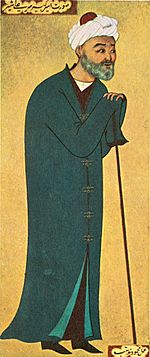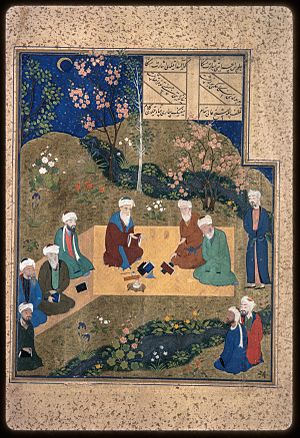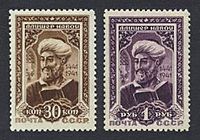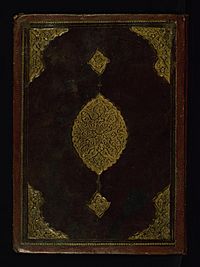Ali-Shir Nava'i facts for kids
Quick facts for kids
Ali-Shir Nava'i
|
|
|---|---|

|
|
| Born | 9 February 1441 Herat, Timurid Empire |
| Died | January 3, 1501 (aged 59) Herat, Timurid Empire |
| Resting place | Herat, Afghanistan |
| Pen name | Navā'ī (or Nevā'ī) and Fāni |
| Occupation | Poet, writer, politician, linguist, mystic and painter |

Ali-Shir Nava'i (born February 9, 1441 – died January 3, 1501) was a famous poet, writer, and statesman from the Timurid Empire. He was also a linguist, a mystic, and a painter. Many people consider him the most important writer in the Chagatai language.
Nava'i believed that his native Chagatai Turkic language was better than Persian for writing poems and stories. This was a very unusual idea at the time. He explained why he thought this in his book called Muhakamat al-Lughatayn, which means The Comparison of the Two Languages. He felt that Turkic words were richer and more precise than Persian ones.
Because of his amazing poetry in Chagatai, many people in Turkic-speaking countries see Nava'i as the founder of early Turkic literature. Many places and schools in Central Asia are named after him.
Contents
Ali-Shir Nava'i was born in 1441 in the city of Herat. His family were well-educated scribes who wrote official documents. During his life, Herat was part of the Timurid Empire. It became a very important center for culture and learning in the Islamic world.
Ali-Shir's father, Ghiyāth ud-Din Kichkina, was a high-ranking officer in the palace. He worked for Shāhrukh Mirzā, a ruler of Greater Khorasan. Ali-Shir's mother was also important, serving as a prince's governess. After his father died, another ruler, Abul-Qasim Babur Mirza, took care of young Ali-Shir.
Ali-Shir went to school with Husayn Bayqarah, who later became the ruler of Khorasan. In 1447, Ali-Shir's family had to leave Herat because of political problems. They returned in the 1450s when things became stable again.
In 1456, Ali-Shir and Bayqarah traveled to Mashhad. After a short time, they went their separate ways. While Bayqarah focused on gaining political power, Ali-Shir continued his studies in Mashhad, Herat, and Samarkand.
When Abu Sa'id Mirza died in 1469, Husayn Bayqarah became the ruler of Herat. Ali-Shir then left Samarkand to join his friend's service. In 1472, Ali-Shir was made a commander of the supreme council. He worked for Bayqarah until his death on January 3, 1501. He was buried in Herat.

Ali-Shir Nava'i was a public administrator and an adviser to his friend, Sultan Husayn Bayqarah. He was also a great builder. It is said that he helped build or restore about 370 mosques, schools (madrasas), libraries, hospitals, and other important buildings in greater Khorasan. In Herat alone, he was responsible for 40 inns for travelers, 17 mosques, 10 mansions, and many other public works.
Nava'i helped make Herat a beautiful city, which some historians have called "the Florence of what has justly been called the Timurid Renaissance". He also supported scholars and artists. He was a musician, a composer, a calligrapher, a painter, and a sculptor. He was such a famous writer that one historian called him "the Chaucer of the Turks".
Many important people received financial help from Ali-Shir. These included historians like Mirkhvand and poets like Jami.
Literary Works
Ali-Shir Nava'i used the pen name Nava'i for his Turkic writings. He was one of the key writers who changed how Turkic languages were used in literature. Nava'i wrote most of his works in the Chagatai language. Over 30 years, he produced 30 works, helping Chagatai become a respected literary language. He also wrote in Persian using the pen name Fāni, and a little in Arabic.
Nava'i's most famous poems are in his four diwans, or poetry collections. These collections have about 50,000 verses. Each part of the work represents a different time in a person's life:
- Ghara'ib al-Sighar ("Wonders of Childhood")
- Navadir al-Shabab ("Rarities of Youth")
- Bada'i' al-Wasat ("Marvels of Middle Age")
- Fawa'id al-Kibar ("Benefits of Old Age")
To help other Turkic poets, Ali-Shir wrote technical books. One was Mizan al-Awzan ("The Measure of Meters"), which explained how to write poetry. He also created Majalis al-Nafais ("Assemblies of Distinguished Men"). This book has over 450 short biographies of poets from his time. It is a very important source of information about Timurid culture for today's historians.
Another important work by Ali-Shir is the Khamsa (Quintuple). This is a collection of five epic poems, similar to the famous Khamsa by Nizami Ganjavi:
- Hayrat al-abrar ("Wonders of Good People")
- Farhad va Shirin ("Farhad and Shirin")
- Layli va Majnun ("Layla and Majnun")
- Sab'ai Sayyar ("Seven Travelers") (about the seven planets)
- Sadd-i Iskandari ("Alexander's Wall") (about Alexander the Great)
Ali-Shir also wrote Lisan al-Tayr, which means "The Language of Birds". This work was inspired by Attar of Nishapur's Mantiq al-Tayr ("The Conference of the Birds"). In it, Nava'i shared his thoughts on philosophy and Sufism, which is a spiritual part of Islam.
His last major work was Muhakamat al-Lughatayn ("The Trial of the Two Languages"), finished in December 1499. In this book, he compared Turkic and Persian languages. He strongly believed that the Turkic language was better for writing literature. He often pointed out how rich, precise, and flexible Turkic words were compared to Persian.
Selected Works
Here are some of Ali-Shir Nava'i's important works:
- Badoe ul-Vasat (Marvels of Middle Age) – A poetry collection with 740 poems, written between 1492 and 1498.
- Waqfiya – A documentary work written in 1481, showing the poet's life and dreams. It's a good source for understanding 15th-century social and cultural life.
- Layli wa Majnun (Layli and Majnun) – An epic poem about a man deeply in love, written in 1484.
- Lison ut-Tayr (The Language of Birds) – An epic poem written between 1498 and 1499. It uses birds to tell a story about people seeking God.
- Majolis un-Nafois – An anthology (collection) of short biographies of poets. Written in 1491–92, it includes information about 459 poets and authors.
- Mahbub ul-Qulub – Nava'i's work from 1500, a year before he died. It has three main parts: about social classes, moral lessons, and wise advice.
- Mezon ul-Avzon – A book about the rules of Persian and Turkic poetry, written in 1490.
- Munojot – A short prose work written in his last years, where Nava'i expresses his prayers and regrets to Allah.
- Munshaot (A Collection of Letters) – A collection of Nava'i's letters written to different people, gathered between 1498 and 1499. It gives insights into political, social, and spiritual matters of his time.
- Muhakamat al-Lughatayn – His famous work from 1499, where he argued for the superiority of the Turkic language over Persian for literary writing.
- Navodir ush-Shabob (Rarities of Youth) – Another poetry collection, compiled between 1492 and 1498.
- Sab'ai Sayyor (Seven Travelers) – An epic poem from his Khamsa, written in 1485.
- Saddi Iskandari (Alexander's Wall) – The fifth epic poem in his Khamsa, written in 1485. It tells about Alexander the Great and Nava'i's ideas on good governance.
- Siroj ul-Muslimin (The Light of Muslims) – A work about Islamic Law written in 1499, discussing the Five Pillars of Islam, sharia, and other religious topics.
- Favoid ul-Kibar (Benefits of Old Age) – The fourth poetry collection in his Hazoin ul-maoniy, written between 1492 and 1498.
- Farhod wa Shirin (Farhad and Shirin) – The second epic poem in his Khamsa, written in 1484. It's a classic love story, often compared to Romeo and Juliet.
- Hazoin ul-Maoniy – The combined title for Nava'i's four main poetry collections, finished in 1498. It contains over 3,000 poems and more than 22,000 verses.

- Khamsa – The common title for his five epic poems, written between 1483–85. This work set a high standard for literature in the Chagatai language.
Nava'i had a huge impact on literature and culture in many places, from India to the Ottoman Empire. His influence can be seen in Central Asia, modern-day Turkey, and other areas where Turkic speakers live.
- Babur, who founded the Mughal Empire in India, was greatly influenced by Nava'i. He wrote about his respect for Nava'i in his own memoirs.
- The Ottoman Turks admired their Central Asian heritage. Süleymân the Magnificent was very impressed by Nava'i's works and had them added to his personal library.
- The famous Azerbaijani poet Fuzûlî was also greatly influenced by Nava'i's writing style.
- In Turkmen literature, Nava'i is seen as a master. The Turkmen poet Magtymguly often mentioned Nava'i in his poems, calling him a brilliant poet and his teacher.
- Nava'i is considered the national poet of Uzbekistan in Uzbek culture. The province of Navoi and many other places, like streets and airports, are named after him. Uzbek writers and poets continue to find inspiration in his works.
Legacy
Nava'i is one of the most loved poets among Central Asian Turkic peoples. He is generally seen as the greatest writer in Chagatai language literature. His skill with the Chagatai language was so great that it became known as "the language of Nava'i".
Many places and institutions in Uzbekistan and other Central Asian countries are named after Alisher Nava'i. These include the Navoiy Region, the city of Navoiy, the National Library of Uzbekistan, the Alisher Navoi Opera and Ballet Theatre, and the Navoi International Airport.
Many of Nava'i's poems are performed in traditional music, especially in the Twelve Muqam. They also appear in popular Uzbek folk songs and in the works of many Uzbek singers. Alisher Nava'i's works have also been turned into plays by Uzbek playwrights.
In 2021, a special event was held in Kazakhstan to celebrate the 580th anniversary of Ali-Shir Nava'i's birth.
See also
 In Spanish: Ali-Shir Nava'i para niños
In Spanish: Ali-Shir Nava'i para niños




